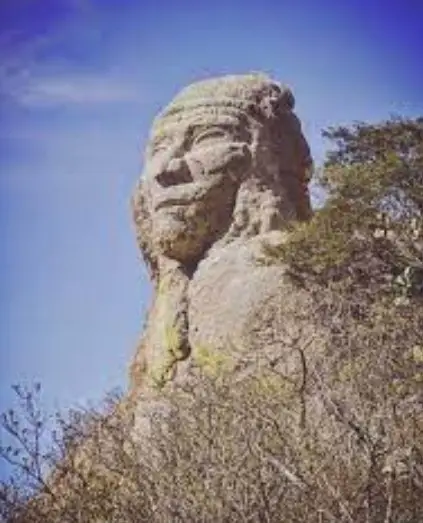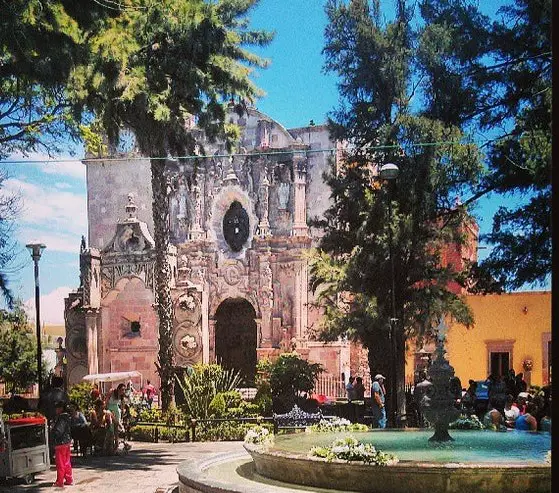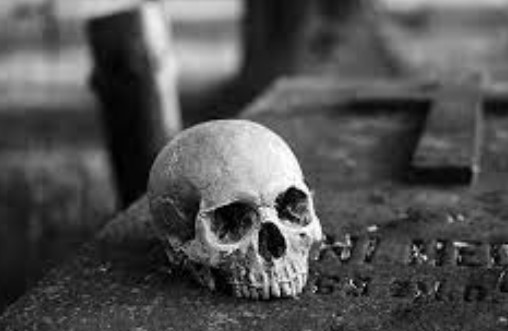Podcast: Play in new window | Download
Subscribe: Apple Podcasts | RSS
Aguascalientes is one of the smallest states in Mexico, located in the north-central part of the country. The capital city of the state is also called Aguascalientes and was founded by the Spanish in 1575. The state is home to 1.5 million people and many legends. Here are four:
- The Chichimeca Giant, Nahuatlaca
In the times before the Spanish arrived in Mexico, the Chichimeca did many battles with invading tribes from both the north and south. They were almost totally exterminated if it wasn’t for the actions of a Chichimec giant named Nahuatlaca. He was seen as a defender of the weak and was considered an invincible demi-god for the feats he had performed to help the Chichimec people survive. After the period of warfare ended, this notorious giant began to abuse his strength and power to the point of becoming a ruthless tyrant who demanded tribute from the inhabitants of this  region, whose lands did not give them what was necessary to cover the giant’s requirements. The great Nahuatlaca, trying to instill fear among those people who did not pay their taxes, crushed them using the terrible weight of his club. The giant’s demands were so disastrous that some groups began to form to conspire against their former savior to try to put an end to this desperate situation. The first conspirators paid with their lives for the attempted rebellion. Despite this, discontent increased against Nahuatlaca, who knew full well that most of his subjects wanted to kill him. Fearful of being assassinated and wanting to put an end to his constant state of anxiety which had become unbearable, the giant implored the protection of the god Natlazahuatl, known to the Chichimecs as Tifo. Nahuatlaca commanded Tifo to drive off or kill all the inhabitants of the region. The obedient Tifo began his destructive work among the people in the immediate area. Tifo made the people have tremendous headaches and then caused them to come down with very high fevers. For those who didn’t leave, they died three to seven days after Tifo’s spell was cast upon them. The first round of this supernatural punishment caused people to be more obedient again, however, discontent was still simmering under the surface of most of the Chichimec people. Those who dared to defy the giant formed a group called “Los Gallos,” or, “The Roosters,” who were the most robust of the Chichimeca warriors and swore to give their lives to defeat the terrible Nahuatlaca. When the giant found out what that group of strong warriors was doing, he directed his anger against them again, but they were then forced to leave their town and headed south in search of higher ground from where they could observe the giant’s movements and direct the attacks. The battle between “Los Gallos” and Nahuatlaca was intense, so the giant retreated to the north. Exhausted, the great Nahuatlaca fell asleep in what he thought was a safe place. The Chichimeca rebels found the giant in a deep sleep, and dropped a large basket called a chiquihuite full of rocks on the giant’s head. They then took large shovels of earth and buried him. The giant slowly became conscious and realized he was buried, and then tried to free himself from his premature grave. Despite the struggle, the chiquihuite full of rocks and the sheer weight of the earth covering him was too much, even for this powerful giant. The Chichimec warriors celebrated their victory but would forever have a sense of reverence and respect whenever they passed the mountain now called Cerro de los Gallos or just Chiquihuite located within sight of the modern-day city of Aguascalientes. Legend has it that even though centuries have gone by, the great Chichimeca giant Nahuatlaca will manage to escape from his prison one day, and then he will destroy the prosperous and happy city of Aguascalientes.
region, whose lands did not give them what was necessary to cover the giant’s requirements. The great Nahuatlaca, trying to instill fear among those people who did not pay their taxes, crushed them using the terrible weight of his club. The giant’s demands were so disastrous that some groups began to form to conspire against their former savior to try to put an end to this desperate situation. The first conspirators paid with their lives for the attempted rebellion. Despite this, discontent increased against Nahuatlaca, who knew full well that most of his subjects wanted to kill him. Fearful of being assassinated and wanting to put an end to his constant state of anxiety which had become unbearable, the giant implored the protection of the god Natlazahuatl, known to the Chichimecs as Tifo. Nahuatlaca commanded Tifo to drive off or kill all the inhabitants of the region. The obedient Tifo began his destructive work among the people in the immediate area. Tifo made the people have tremendous headaches and then caused them to come down with very high fevers. For those who didn’t leave, they died three to seven days after Tifo’s spell was cast upon them. The first round of this supernatural punishment caused people to be more obedient again, however, discontent was still simmering under the surface of most of the Chichimec people. Those who dared to defy the giant formed a group called “Los Gallos,” or, “The Roosters,” who were the most robust of the Chichimeca warriors and swore to give their lives to defeat the terrible Nahuatlaca. When the giant found out what that group of strong warriors was doing, he directed his anger against them again, but they were then forced to leave their town and headed south in search of higher ground from where they could observe the giant’s movements and direct the attacks. The battle between “Los Gallos” and Nahuatlaca was intense, so the giant retreated to the north. Exhausted, the great Nahuatlaca fell asleep in what he thought was a safe place. The Chichimeca rebels found the giant in a deep sleep, and dropped a large basket called a chiquihuite full of rocks on the giant’s head. They then took large shovels of earth and buried him. The giant slowly became conscious and realized he was buried, and then tried to free himself from his premature grave. Despite the struggle, the chiquihuite full of rocks and the sheer weight of the earth covering him was too much, even for this powerful giant. The Chichimec warriors celebrated their victory but would forever have a sense of reverence and respect whenever they passed the mountain now called Cerro de los Gallos or just Chiquihuite located within sight of the modern-day city of Aguascalientes. Legend has it that even though centuries have gone by, the great Chichimeca giant Nahuatlaca will manage to escape from his prison one day, and then he will destroy the prosperous and happy city of Aguascalientes.
- The Lizard Man in the Pool
 Water has always had magical and religious significance throughout time and across cultures and Mexico is no exception. In the 1880s in the city of Aguascalientes a series of stories began to circulate about a pool of water, a pond called Del Campanero, which was formed at the crossroads of Paso de Curtidores with the San Pedro River. The exact location of this pool today is near the intersection of the extension of Calle Salvador Quezada Limón and the San Pedro River. It is known that the pool was used to bathe the soldiers’ horses, but it is also identified as the home of a mythical creature, a sort of lizard-man, known as the Chan del Agua. He is bright green with scales and a long tail. He has large thorns on his back, and he walks perfectly upright. The Chan is amphibious and can survive for long periods of time underwater. The legend of this reptilian humanoid dates back into pre-Hispanic times and no one knows for how many centuries people have been sighting the Chan. According to rumors around town in the 1880s the Chan was responsible for many pregnancies of young ladies who supposedly had bathed in the pond and had encounters with the creature. This notorious reptilian was thus blamed for many babies being born out of wedlock in the 1880s. Some of the church records of the time, the parish registers of births, include entries with the surname “Chan del Agua” for the name of the father. It turns out blaming a legendary creature for a pregnancy was better than the alternative, which was admitting the truth of pre-marital relations. Many people, however, did believe that the Chan was responsible and so many people were off the hook.
Water has always had magical and religious significance throughout time and across cultures and Mexico is no exception. In the 1880s in the city of Aguascalientes a series of stories began to circulate about a pool of water, a pond called Del Campanero, which was formed at the crossroads of Paso de Curtidores with the San Pedro River. The exact location of this pool today is near the intersection of the extension of Calle Salvador Quezada Limón and the San Pedro River. It is known that the pool was used to bathe the soldiers’ horses, but it is also identified as the home of a mythical creature, a sort of lizard-man, known as the Chan del Agua. He is bright green with scales and a long tail. He has large thorns on his back, and he walks perfectly upright. The Chan is amphibious and can survive for long periods of time underwater. The legend of this reptilian humanoid dates back into pre-Hispanic times and no one knows for how many centuries people have been sighting the Chan. According to rumors around town in the 1880s the Chan was responsible for many pregnancies of young ladies who supposedly had bathed in the pond and had encounters with the creature. This notorious reptilian was thus blamed for many babies being born out of wedlock in the 1880s. Some of the church records of the time, the parish registers of births, include entries with the surname “Chan del Agua” for the name of the father. It turns out blaming a legendary creature for a pregnancy was better than the alternative, which was admitting the truth of pre-marital relations. Many people, however, did believe that the Chan was responsible and so many people were off the hook.
- Calle de la Estrella
 In the oldest barrio of the city of Aguascalientes, the Encino neighborhood, there lived a pretty young woman, a girl of ease and grace known as Azucena Puñales. Her life was like a fairy tale, and she had so many suitors she did not know how to decide on any of them. She, with a soft voice, always told them yes, but she proceeded with a tranquil patience. Her subtle hard-to-get approach caused the men around town to desire her even more. Azucena did not want to hurt the feelings of those in love with her, since they all expressed their desire for marriage. Her good parents, moderately well off, had had her almost halfway through their marriage. Months passed, perhaps years, and one day Azucena’s father died. It was not nine months later that her mother also died. Loneliness and silence fell over Azucena’s house like a large, long shadow. The beautiful lady, though alone in that house, still had visits from many handsome and wealthy men. For some strange reason, each one of these men died, and one by one, with hope until the end, they made Azucena the heir to their fortunes. When the last of her suitors died, Azucena, being already old and rich, went to work at the house of Lorenzo Mateo Caldera as a housemaid, just for the human contact and not out of need for money. Years passed and Lorenzo fell ill. Once again, the story was repeated: Azucena inherited the belongings of the wealthy older man, including his mansion. From luck alone, Azucena became the wealthiest woman in Aguascalientes. Everyone in the Encino neighborhood said that Azucena was born under a Good Star and that’s how the street on which Lorenzo’s mansion was located got its name: Calle de la Estrella, or Street of the Star.
In the oldest barrio of the city of Aguascalientes, the Encino neighborhood, there lived a pretty young woman, a girl of ease and grace known as Azucena Puñales. Her life was like a fairy tale, and she had so many suitors she did not know how to decide on any of them. She, with a soft voice, always told them yes, but she proceeded with a tranquil patience. Her subtle hard-to-get approach caused the men around town to desire her even more. Azucena did not want to hurt the feelings of those in love with her, since they all expressed their desire for marriage. Her good parents, moderately well off, had had her almost halfway through their marriage. Months passed, perhaps years, and one day Azucena’s father died. It was not nine months later that her mother also died. Loneliness and silence fell over Azucena’s house like a large, long shadow. The beautiful lady, though alone in that house, still had visits from many handsome and wealthy men. For some strange reason, each one of these men died, and one by one, with hope until the end, they made Azucena the heir to their fortunes. When the last of her suitors died, Azucena, being already old and rich, went to work at the house of Lorenzo Mateo Caldera as a housemaid, just for the human contact and not out of need for money. Years passed and Lorenzo fell ill. Once again, the story was repeated: Azucena inherited the belongings of the wealthy older man, including his mansion. From luck alone, Azucena became the wealthiest woman in Aguascalientes. Everyone in the Encino neighborhood said that Azucena was born under a Good Star and that’s how the street on which Lorenzo’s mansion was located got its name: Calle de la Estrella, or Street of the Star.
- The Flying Skull in the Cemetery
Jesús Infante, a mason and stone carver, made a commitment to Don Carlos Espino, to finish a monument in memory dedicated to his relatives and that he should deliver it on the agreed day. But it happened that on the day the monument was to be delivered, at o’clock at night, Jesús was still working on it in the cemetery. That being the case, when he went through one of the corridors to bring some wedges that were missing, Jesús felt some fear, hearing a strange noise behind him, a “clack, clack, clack.” He then felt as if water had been poured down his back and his legs were bending. He struggled to turn around only to see a disembodied skull hovering in the air, moving its jaws so strongly so as to make that horrible clacking sound. The skull then started to speak. It said this to the trembling Jesús who was paralyzed:
 “Take pity on my sorrows that torment me in purgatory. I am fifty years old without rest. Ask my grandfather your grandfather’s father about the ten thousand pesos in silver that are at the foot of the cupboard that is in the kitchen a foot and a half deep. You will give fifty pesos to the priest who will say three masses in my name. I will reward you by releasing you from your paralysis. If you don’t comply, you will be like this forever and you will never heal.”
“Take pity on my sorrows that torment me in purgatory. I am fifty years old without rest. Ask my grandfather your grandfather’s father about the ten thousand pesos in silver that are at the foot of the cupboard that is in the kitchen a foot and a half deep. You will give fifty pesos to the priest who will say three masses in my name. I will reward you by releasing you from your paralysis. If you don’t comply, you will be like this forever and you will never heal.”
Jesús felt a power release him and he could move his legs, so he started running. The skull flew after him, clacking its jaws, almost biting his back. The poor stonecutter dropped his tools and was scared to return to the cemetery, although he had to finish the monument for the Espino family. The next day Jesús was accompanied by a friend so that he could finish his project as soon as possible, and never return. While working, Jesús became so ill that his body once again became paralyzed. His body also became very cold, and he started shaking uncontrollably. He said out loud, so the skull would hear, that he would comply with its wishes and find the hidden money. He was released once again and followed the skull’s orders. After paying the priests for the masses, Jesús’ life returned to normal, and he no longer feared working in the cemetery. When he told his friends about this case, they told him that it was already well known to everyone and that Joaquin Sánchez had also experienced the same incident but he had not responded to the skull’s pleas. The skull drove Joaquin crazy and caused him to jump off the high wall of the cemetery to his death. To this day, people tell of cases of the flying skull of the graveyard and caution others to enter the cemetery at their own risk.
REFERENCES
Mil gracias to the website of the State of Aguascalientes for helping with these legends
